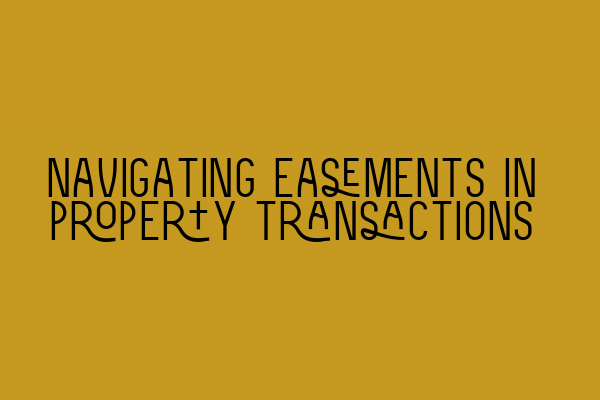Navigating Easements in Property Transactions
Easements are an essential aspect of property law, governing the rights and responsibilities between property owners and non-owners in relation to the use and enjoyment of land. Understanding easements is crucial for both property solicitors and individuals involved in property transactions, as any issues surrounding easements can significantly impact the value and usability of a property.
In this blog post, we will dive deep into the world of easements, exploring what they are, how they are created, and how they can be managed in property transactions. So, grab a cup of coffee and let’s get started!
What is an Easement?
An easement is a legal right held by one person to use the land belonging to another person in a particular way. It grants certain privileges and access rights to the person holding the easement, known as the “dominant owner,” while placing corresponding restrictions on the use of the land by the “servient owner.”
Common examples of easements include rights of way (which allow access to and from a property), rights to light (which protect access to natural light), and rights to drainage or services.
Creating an Easement
Easements can be created in a variety of ways, and it is crucial to understand the methods involved to ensure compliance with property law. Here are some common ways easements can be created:
1. Express Grant: This is when the servient owner explicitly grants an easement to the dominant owner through a written document, such as a deed. The terms and conditions of the easement, including its scope and limitations, should be clearly stated in the document.
2. Implied Grant: In some situations, an easement can be implied based on the circumstances surrounding the property. For example, if two parcels of land were previously owned by the same person and one was later sold, it could be implied that the newly divided property has an easement over the sold portion for access or drainage purposes.
3. Prescription: When a person has openly and continuously used another person’s land without permission for a specified period (usually 20 years), they may gain an easement by prescription. However, this method requires strict adherence to legal requirements and proof of continuous use.
Managing Easements in Property Transactions
When it comes to property transactions, easements can significantly impact the value and usability of a property. Therefore, it is crucial to consider easements carefully and address any potential issues before completing a transaction. Here are some key steps to navigate easements in property transactions:
1. Identify Existing Easements: Conduct a thorough title search to identify any existing easements that may affect the property. This can be done by reviewing the title register, plans, and any relevant deeds. It is also advisable to consult an experienced property solicitor who can assist in identifying and understanding the implications of any identified easements.
2. Obtain Consent: If the property you are buying or selling is subject to an existing easement, it is essential to obtain the necessary consents from the dominant owner. This will ensure that the easement rights are legally transferred to the new owner.
3. Disclose Easements: Sellers have a legal obligation to disclose any known easements affecting the property to potential buyers. Failure to disclose relevant easements could lead to legal disputes or even financial claims in the future. Buyers should also undertake their due diligence and ask specific questions about easements during the conveyancing process.
4. Modify or Terminate Easements: In some cases, it may be necessary to modify or terminate existing easements to meet the specific requirements of a property transaction. This can be done through negotiation and mutual agreement between the dominant and servient owners or, if necessary, through legal action.
Conclusion
Easements play a vital role in property transactions, dictating the rights and responsibilities between owners and non-owners. Navigating easements requires a deep understanding of property law and careful attention to detail. By identifying existing easements, obtaining necessary consents, disclosing relevant information, and addressing any issues that may arise, property transactions can proceed smoothly and without any unexpected legal complications.
If you’re preparing for the SQE exams, you might find the following related articles helpful:
– SQE 1 Practice Exam Questions
– SQE 1 Practice Mocks FLK1 FLK2
– SQE 2 Preparation Courses
– SQE 1 Preparation Courses
– SRA SQE Exam Dates
Remember, when it comes to easements in property transactions, seeking professional guidance from experienced property solicitors, like the experts at SQE Property Law & Land Law, can provide you with the necessary knowledge and assistance to navigate the complexities of easements and ensure a successful property transaction.
